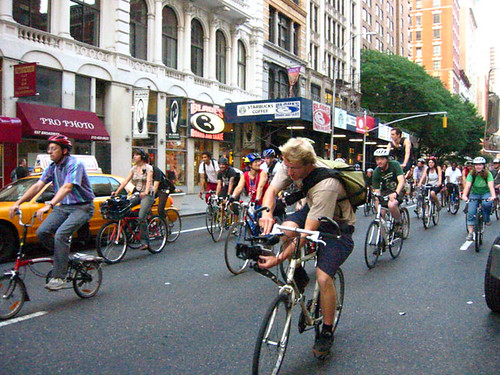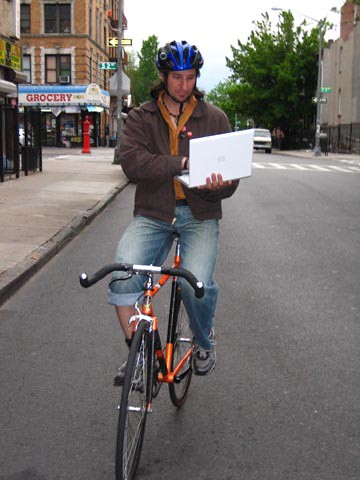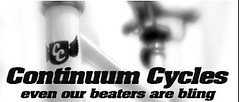everyones shoots video...
This is a picture from the June 05 Critical Mass NYC.
Clarification on the Memorial tomorrow. I believe it will take place in 4 different locations. This is not a ride. Goto the location closest to you or closest to your heart. Bring flowers, candles, speeches, etc. Wave to the undercover cops who have no soul and come to a memorial of a killed person. They'll be the ones wearing Yankees jerseys and talking on the cell phone.
Here is a counter punch article sent to me from Benjamin Shepard, a life long activist here in NYC.
www.counterpunch.org/shepard06182005.html
++This is a very long article that should be looked up on line. It covers activism over the last couple of years from RNC to Miami FTAA. Lots of info here. This is only one brief section+++
August 27, 2004: The attack on Critical Mass
A helicopter pulsed overhead as nervous activists meandered around St. Mark's Church in the minutes after over several hundred bikers were arrested during for participating in a community bike ride on August 27, the Friday night preceding the RNC. Earlier in the evening, some 5,000 bikers had formed a cavalcade through the summer night. The ride was the culmination of a near-decade of bike and public space activism (Shepard and Moore, 2002). After years of theme-based Critical Mass bike rides supporting community gardens, nonpolluting transportation, even a commemoration of lost firemen after 9/11, the summers of 2003 and 2004 brought thousands of new members into New York's public space/environmental activism. Throughout the spring and summer of 2004, activists across the country recognized that the last Friday of August dovetailed with the RNC protests. Critical Mass rides took place around the world on the last Friday of every month. Anticipating the RNC, riders careened across the FDR freeway during the July 30 ride--the last ride of "the fun old days" of Critical Mass. By the next month, everything would be different.
By August, organizing efforts were met with government surveillance and attempts at total control of the monthly Critical Mass rides. During the last week of the month, police began making routine visits to the TIME'S UP! space (headquarters of the local bike activist group), where they asked about the whereabouts of a number of organizers who were on their radar. Surveillance, such as visits to the homes and workplace of activists known to be effective organizers, was common during the days before the RNC.
Two days before the August ride, organizers were informed that they could not hold their planned after-party at the Frying Pan, a regular venue for political parties and fundraisers, including many previous dance parties after Critical Mass rides. Apparently, the police, the Coast Guard, and others had flooded the Frying Pan owners with phone calls. Under heat from the federal government, the owners canceled the party. The Critical Mass rides and after-parties are events at which the roving activist social world converges on a monthly basis. Without opportunities to get together, these communities face the threat of oblivion. Once again, a community event was being attacked under the auspices of "zero tolerance" policing. That night, organizers distributed a flyer reading:
Important Message to Our Community.
Our beloved Critical Mass Ride is under attack!
All threats, intimidation tactics and harassment, however, will not keep us from going forward with this amazing community ritual! We have worked hard to build this dynamic community and to advocate for the rights of those that use alternative modes of transportation! We have worked hard to reclaim our rights to public space in our city of New York!
The message implored ride supporters to come out in force. It emphasized community interrelatedness, play, and pleasure as responses to the impending panic, and specifically called on riders not to cave in to a culture of fear and intimidation:
Tell all your friends. Bring family, neighbors, lovers and strangers. Bring noisemakers, musical instruments, face-paint, flowers, and your energy and joy. Bring things to juggle and to share and also your conviction that we have a right to converge and ride throughout this glorious city. Bring video cameras.
We will not be intimidated!
We will not be threatened and harassed!
This is our city! This is our community!
Let's make this the biggest, loudest, most joyful Critical Mass ever!
That Friday night, 5,000 riders--both locals and itinerant activists in town for the RNC--responded to the call. It was the largest Critical Mass ride in New York City history. Those who participated encountered the brand of demonization of protest and community building that had become a typical feature of the Patriot Act era. Over 250 riders were arrested that night; another 150 bicyclists were arrested by the time the RNC had ended, totaling over 400 bike arrests during the RNC alone.
"Police hate to be upstaged," one observer involved in radical gardening and biking noted. Both community gardening and bicycling had become targets of government crackdowns because they both seemed to advocate a vision of urban life in which care and connection with neighbors was prioritized over policing, security culture, and entrance fees. Both community gardening and biking challenged notions of the city as profit-making growth machine.
In the case of Critical Mass, the police appeared to be responding to the prefigurative "Yes"--the community-building process and the spontaneous ritual of community that unfolded the last Friday of every month. Activists had created an image of urban life built on affective play: bike riding amongst friends and neighbors in a healthy sustainable city. These rides functioned as open-ended, leaderless democratic free-for-alls--compelling spaces open for more and more bikers to participate. The police seemed upset that a group of citizens was not interested in asking for permission or asking them to play a role in helping organize their leaderless community. For many, the ride had become a sort of living example of noncommidified possibility. Thus, Critical Mass represented a powerful "Yes" to life, community, and authentic fun in a world of "Nos." While the police formed a security detail for the malling of Manhattan and the suburbanization of NewYork, Critical Mass rides represented a form of community building that had nothing to do with citizenship as shopping endeavor.












0 Comments:
Post a Comment
<< Home